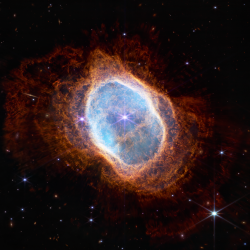
Friday 7 October | 18:30
Event organised by EGO - European Gravitational Observatory. National Institute of Nuclear Physics, Department of Physics, University of Pisa.
The evening open to all is a dialogue at the frontier of our knowledge of the Universe with spectacular images from the James Webb Space Telescope and the Event Horizon Telescope and the sounds of gravitational waves revealed by Virgo.
The dialogue at the frontier of our knowledge of the Universe will feature Steven Shore of the University of Pisa, researcher at the James Webb Telescope; Mariafelicia De Laurentis, University Federico II of Naples and INFN and researcher at the Event Horizon Telescope; and Stavros Katsanevas, Director of the European Gravitational Observatory in Pisa.
The second and eagerly-awaited evening to talk about the Cosmos arrives at the Pisan Garden after the applauded meeting Women listening to the Cosmos, which last week saw the intervention of the three female scientists Pia Astone, Ornella Juliana Piccinni and Julia Casanueva on the theme of Virgo's challenges in listening to the signals of the Universe's most remote and violent phenomena.
Exploring, observing and listening to the remote Universe, at ever greater distances from Earth and with ever greater precision and sensitivity. On Friday 7 October at the Nunziatina, some of the protagonists of the most extraordinary scientific endeavours of recent years will tell us how close we can now get to the boundaries of the Cosmos with large telescopes and 'antennas' on Earth and in space. Like the James Webb Telescope, the Nasa, Asc and Esa space telescope that opened its eyes to deep space just a few months ago and sent us images of galaxies and remote regions of the Universe as never before. Another extraordinary photograph, this time of one of the most extreme and mysterious cosmic objects, the black hole at the centre of the Milky Way, was taken by the planetary network of radio telescopes, called the Event Horizon Telescope (EHT). These antennas scattered around the Earth were able to pick up radio signals emitted by the incandescent matter surrounding the event horizon, the boundary beyond which matter and light disappear, swallowed up by the black hole. Finally, the meeting's topics could not fail to include the (probably) greatest astronomical revolution of this century: that of gravitational waves, revealed by the LIGO gravitational antennas in the USA and Virgo, in the province of Pisa, listening for violent and remote cosmic phenomena, such as mergers of black holes and stars.